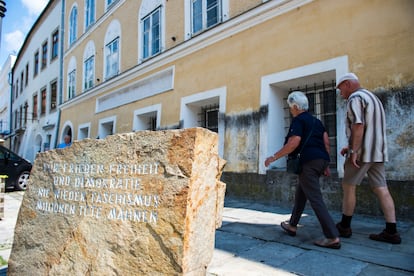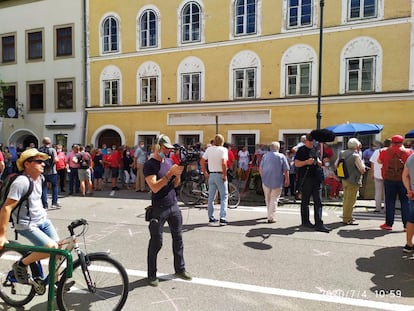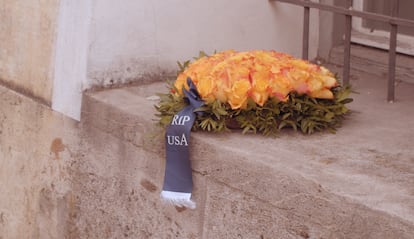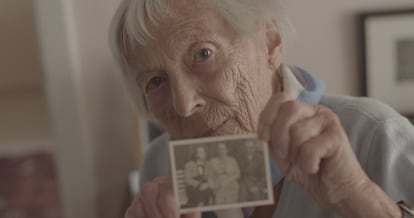A cinematic exorcism for Hitler’s birthplace
An extraordinary documentary delves into the bitter debate over the fate of the building in the Austrian city of Braunau where the Nazi leader was born


Braunau am Inn has the dubious privilege of appearing in the first sentence of the first chapter of Mein Kampf. Adolf Hitler explains there that he considers it a “fortunate destiny” to have been born (at 6.30 p.m. on April 20, 1889, a cloudy Saturday, as noted in his biography of reference by Ian Kershaw) in the small Austrian town. A town, Hitler continues, “situated just on the frontier between those two States [Austria and Germany] the reunion of which seems, at least to us of the younger generation, a task to which we should devote our lives and in the pursuit of which every possible means should be employed.” Hitler goes on to say how little he remembers of his life in Braunau am Inn, which is logical because when he was not yet three years old his father Alois, a customs officer, was promoted and the family moved to Passau in Bavaria, on the other side of the border. In 1898, they moved again, this time to Leonding in the district of Linz. And it is Linz that he always considered his hometown and which he wanted later, when he was in power, to become the most beautiful city on the Danube and the cultural counterweight to Vienna, which he detested so much.
The fact that Hitler does not seem to have cared too much about Braunau am Inn — his homes were his Munich apartment, his second residence at the Berghof, and the chancellery (including the bunker) — has not managed to save the town from the curse of being called “the cradle of evil,” where the Nazi leader was born, and from having to carry that burden since the end of World War II, when everyone hid their portrait of the once beloved Führer.
The fact is that the building in which Hitler was born, at 15 Salzburger Vorstadt, has remained quite unchanged over time, causing — apart from considerable embarrassment and dangerous neo-Nazi interest — a bitter debate about what to do with it, both in the city and in Austria as a whole. Austrian filmmaker Günter Schwaiger has devoted himself to following this controversy, from a very interesting personal, moral and committed perspective, in the documentary Who’s Afraid of Hitler’s Town, subtitled “A House and the Past Inside Us.”
The film tackles the thorny question of the house by surveying the opinions of the inhabitants of Braunau, a place that, as one of them laments, already has brown in its name (Braun, as in Braunhemden, the brown shirts worn by the Nazi Party’s paramilitary Sturmabteilung, the SA, not to mention Eva Braun). From the outset it becomes clear that a large part of Austrian society is not at all happy to have Hitler as a compatriot; they prefer Sissi and Mozart. This is summed up in the joke that the Austrians have managed to convince the world that Hitler was German and Beethoven was Austrian. One interviewee in Vienna even suggests shifting the border a bit so that Braunau is on the German side.
What to do with the house — shuttered since 2016 — is the central question that runs through the entire film, and the fate of the property becomes a metaphor for the conscience and memory of the inhabitants of Braunau, and by extension of all Austrians. Schwaiger has residents, historians, and authorities speak, people of different ideologies, with different opinions. Some consider the house “a stigma” for the city, others ridicule so much controversy over “a house in which nothing happened, no crimes were committed, and no orders were issued.”
It is recalled that a Braunau resident threw a bucket of water at young men in SA uniforms who came to celebrate Hitler’s 90th birthday. “If they don’t come here, they’ll go somewhere else,” remarks another. The opinions of the centenarian former deputy mayor, Lea Olczak, a woman of mettle with a father killed in Mauthausen and who is so similar in appearance to journalist Gitta Sereny, who interviewed Nazi war criminals, are noteworthy. “Did I experience fear under the Nazis? I could write a book about fear.”

Among the most impactful sections of the film is the hidden camera footage of what happens outside the house during a whole day of another Hitler birthday (a neo-Nazi arriving from Berlin lays a wreath “to our blessed Adolf” and gets into an argument with a neighbor who dislikes the tribute, while the neo-Nazi appeals to freedom of speech), the poignant Holocaust reflections by some mentally disabled people from the Lebenshilfe community institution (one of the better ideas was to bequeath the house permanently to them, and enjoy imagining the rage Hitler would have felt), and the scenes shot indoors when Schwaiger and his crew are granted exceptional access.
“I was surprised by its simplicity and normality,” the filmmaker tells this newspaper about his visit to the interior of the empty house. “I imagined, like everyone else, a sinister place. I expected something dark, damp, with a negative aura, and what I found was the opposite; an open space, with many windows. Nothing that could induce a gloomy or rotten feeling. The symbology is in the head.” In fact, Hitler barely lived in the house. It is assumed, Schwaiger says, that he was born in a small room on the second floor. When the family left, the property became a rental house, housed a school and a restaurant, and had other uses until Martin Bormann, Hitler’s powerful private secretary, bought it and gave it to him. The Nazis installed a room where Hitler was supposedly born to foment the myth, with furniture that was never there, and in the house and its surroundings the anniversary was celebrated animatedly, with a profusion of swastikas, as can be seen in footage from the era recovered for the film.

The idea of the intrinsic evil of the dwelling, contemplating it as a house of horrors or something out of The Exorcist, with the Hitler child on the top floor turning his head 360 degrees like the possessed Regan, is dangerous, Schwaiger reflects, because it reinforces the idea of Hitler’s individual evil: to believe that he was like the child in The Omen to the detriment of collective responsibility for the crimes of the Third Reich.
Schwaiger, 58, who hails from Neumarkt am Wallersee, 12 miles from Salzburg and 25 from Braunau, and whose brother (who appears in the film) lives in Hitler’s hometown, warns against the widespread and reassuring (and also false) assertion that Austria was the first victim of the Nazis, that Nazism came to them from the outside, and that Hitler was little less than an alien and his house an Area 51, when six million Austrians were members of the Nazi party, proportionally more than Germans, and also provided some of the worst criminals of the regime, among them Kaltenbrunner, Globocnik and Frank Stangl, the commandant of Treblinka.
“The fact that Hitler’s house is seen as a gloomy mansion of evil frees you from having to make a serious reflection,” he says, “and hence the proposals to keep it closed, demolish it or reform it, modifying the facade, until it becomes unrecognizable.” For the director, who has his own parents talk with remarkable nostalgia about the old days under Nazism and how much “fun” it was to be a member of the Hitler Youth, the house needs another kind of exorcism that is not that of Merrin and Karras: it must become a place of memory, “that shows how the whole nation was involved to the marrow in Nazism, that the Nazis were not an evil group that raped Austria, but a movement that was born here.” And he stresses: “The house should give us the opportunity to meditate on our past as a country of executioners, to explain how evil can grow from normality. We must confront ourselves with truth and guilt.”

Unfortunately, as the documentary shows, the Austrian authorities, who acquired the house in 2016 (it is under the control of the Ministry of the Interior), have not been in the mood. They have even gone so far as to want to remove “the stone of peace,” the monolith (from the Mauthausen quarry) installed in 1989 in front of the house with the inscription: “For peace, freedom and democracy. Never again fascism. Millions of dead are a warning,” provoking widespread protests.
The final decision about the house — for the time being, as Schwaiger warns that the next elections in Austria scheduled for September 29 could produce a far-right chancellor and anything could happen — was to “neutralize” it: modify the facade to return it to its 18th-century appearance and convert it into a police station. The works were supposed to start in 2020 and finish in 2022, but they started timidly last October and are now at a standstill. The house remains in limbo. That said, the budget for the work has shot up from €5 million to €22 million. The new timetable states that the refurbishment will be completed in 2025 and the police station will be operational in 2026. The debris produced by the renovation will be guarded and disposed of discreetly, so that it is not converted into neo-Nazi memorabilia and relics. The film intended to document the process, but with the delays it has had to modify its approach as it goes along. “It was going to be a classic documentary, but I was forced to change it and take it to more emotional terrain,” says Schwaiger.
For the filmmaker, simply changing the facade is an exact metaphor for Austria’s relationship with its Nazi past. “As Thomas Bernhard said: we are a nation of theatricals, changing on the outside so that everything stays the same on the inside.” And he finds the idea of the police station scandalous. Not only because of the active participation of the German and Austrian police in the Holocaust and the linking of Hitler’s house to an armed and uniformed force (“only an army barracks would be a worse decision,” he says), but because, according to a document whose discovery is shown in the film, the Nazis and Hitler himself wanted to give it an official administrative use. “It is a terrible irony of history that the Austrian democratic authorities’ decision regarding the house is so much in line with Hitler’s wishes,” he says.
Cinematographically, taking the documentary towards moral reflections (“I can’t just be an observer”) has made the director use artistic resources capable of translating the interior landscape into images, with metaphors such as the forest or the road, trying to reproduce dreamlike spaces or mental states. “It’s the most difficult film I’ve ever made in my life,” says Schwaiger. “Hitler’s house is a place inside us.”
Sign up for our weekly newsletter to get more English-language news coverage from EL PAÍS USA Edition
Tu suscripción se está usando en otro dispositivo
¿Quieres añadir otro usuario a tu suscripción?
Si continúas leyendo en este dispositivo, no se podrá leer en el otro.
FlechaTu suscripción se está usando en otro dispositivo y solo puedes acceder a EL PAÍS desde un dispositivo a la vez.
Si quieres compartir tu cuenta, cambia tu suscripción a la modalidad Premium, así podrás añadir otro usuario. Cada uno accederá con su propia cuenta de email, lo que os permitirá personalizar vuestra experiencia en EL PAÍS.
¿Tienes una suscripción de empresa? Accede aquí para contratar más cuentas.
En el caso de no saber quién está usando tu cuenta, te recomendamos cambiar tu contraseña aquí.
Si decides continuar compartiendo tu cuenta, este mensaje se mostrará en tu dispositivo y en el de la otra persona que está usando tu cuenta de forma indefinida, afectando a tu experiencia de lectura. Puedes consultar aquí los términos y condiciones de la suscripción digital.
More information
Archived In
Últimas noticias
A hybrid building: Soccer pitch, housing, and a shopping mall
Europe urges Trump to respect Greenland following annexation threats
Science seeks keys to human longevity in the genetic mixing of Brazilian supercentenarians
Luisa Neubauer, climate change activist: ‘Ecology shouldn’t be a punitive force, but a joyful and liberating one’
Most viewed
- Alain Aspect, Nobel laureate in physics: ‘Einstein was so smart that he would have had to recognize quantum entanglement’
- Mexico’s missing people crisis casts a shadow over World Cup venue
- Alvin Hellerstein, a 92-year-old judge appointed by Bill Clinton, to preside over Maduro’s trial in New York
- Why oil has been at the center of Venezuela-US conflicts for decades
- Cuba confirms death of 32 of its citizens in the US attack against Venezuela










































